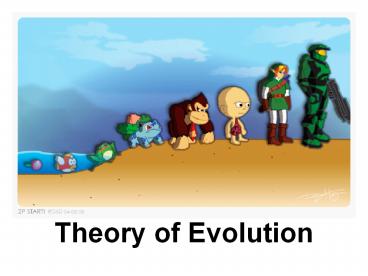Theory of Evolution - PowerPoint PPT Presentation
1 / 16
Title:
Theory of Evolution
Description:
Theory of Evolution – PowerPoint PPT presentation
Number of Views:206
Avg rating:3.0/5.0
Title: Theory of Evolution
1
Theory of Evolution
2
Charles Darwin
- Charles Robert Darwin
- Born February 12 1809 April 19 1882)
- He was an English Naturalist
- He published his theory of evolution with
evidence In his 1859 book On the Origin of
Species.
3
The voyage of the Beagle
- In December 1831, the British ship HMS Beagle set
sail from England on a five year trip around the
world. - Darwin was on board as a naturalist
- His job was to learn as much as possible about
the living things he saw on the voyage. - Darwin's observations led him to develop one of
the most important scientific theories of all
time the theory of evolution by natural
selection.
4
Darwins voyage
5
Darwins Observations
- Darwin made many observations along his stops on
the Beagle - Darwin's observations included the diversity of
living things, the remains of ancient organisms,
and the characteristics of organisms on the
Galapagos Islands. - Darwin was amazed by the tremendous diversity of
living things. Scientists now have identified
more than 1.7 million species of organisms. - A species is a group of similar organisms that
can mate with each other and produce fertile
offspring.
6
The Galapagos Islands
- In 1835 the Beagle reached the Galapagos Islands,
where Darwin observed many unusual life forms on
these small islands such as giant tortoises and
giant iguanas. - When Darwin returned to England, he compared
organisms to organisms that lived elsewhere. He
also compared organisms on different islands in
the Galapagos group. - He was surprised by some of the similarities and
differences he saw.
7
- Darwin found many similarities between Galapagos
organisms and those in South America. However,
there were important differences. - The Iguanas on the Islands had large claws that
allowed them to grip slippery rocks while the
iguanas on the mainland had smaller claws to
climb trees.
- From his observations, Darwin hypothesized that a
small number of plants and animals had come to
the islands from the mainland. - Once they reached the islands, the reproduced.
Eventually their offspring became different from
their mainland relatives.
8
(No Transcript)
9
(No Transcript)
10
Adaptations
- Like the tortoises, the finches on the Galapagos
Islands were noticeably different from one island
to the next. - The most obvious difference on the Finches was
their beak size and shape. - Darwin proposed that each species of finch had a
different size and shaped beak to suit its
environment. This is an example of an Adaptation. - An Adaptation is a trait that helps an organism
survive and reproduce.
11
(No Transcript)
12
Evolution
- Darwin wanted to understand the different
adaptations of organisms on the Galapagos
Islands. - He hypothesized that the species gradually
changed over many generations and became better
adapted to the new conditions. - The gradual change in species over time is called
EVOLUTION.
13
Natural Selection
- In 1858, Darwin and Alfred Russell Wallace, each
proposed an explanation for how evolution could
occur in nature. - Darwin proposed that evolution could happen by
natural selection. - Natural selection is the process by which
individuals that are better adapted to their
environment are more likely to survive and
reproduce than other members of the same species.
14
- Darwin identified factors that affect Natural
Selection - 1. Overproduction Most species produce many more
offspring that can possible survive. - 2. Variations any difference between individuals
of the same species. - 3. Competition because resources are limited,
members of a species must compete with each other
to survive.
15
- 4. Selection Darwin proposed that over a long
time, natural selection can lead to change.
Helpful variations may gradually accumulate in a
species while the unfavorable ones disappear. - 5. Environmental change A change in the
environment can affect the organisms ability to
survive.
16
(No Transcript)































